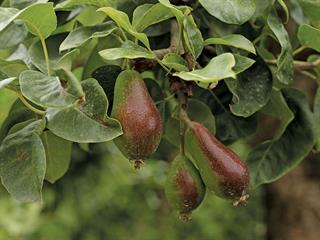
One of the key features of a middle-class lifestyle is the ability to pay for variety – in food as much as anything else. And growing prosperity in Asia, coupled with many Eastern consumers’ preference for sweeter varieties, are driving new trends in fruit production.
In future, upmarket consumers will no longer be satisfied with a Pink Lady apple with a healthy blush. They will be looking for a new eating experience, such as a Pink Lady with pink or red flesh. And, for those consumers who don’t like the tarty flavour of the existing variety, there will be a sweet alternative. So says Riaan van Wyk, one of the directors of the fruit breeding company, re:inc innovation.
Van Wyk stresses that the money-spinning varieties of the future will have to comply with three criteria: they should be visually attractive, taste delicious and be producer-friendly.
“Getting this recipe right won’t be easy. But if you’ve succeeded, you’ve hit the jackpot. A good example of a variety that managed to marry all these requirements is the Nardorcott mandarin, also known as ClemenGold. These easy-peelers look and taste great, but they also have a long shelf-life and produce good yield,” says Van Wyk.

Riaan van Wyk
General trends
To get the consumers’ attention, new varieties should either have unusually intense colour or be markedly different from what is already available. An example of this, explains Van Wyk, is a bi-coloured grape variety that is already being sold in Europe. It is green with a red blush and has a strong mango flavour.
To ensure that the consumer will seek out the variety again, the fruit has to result in a good eating experience in terms of taste, flavour, texture and bouquet. Breeders no longer focus merely on producing fruit that tastes a certain way, such as sweet, sour or tart; they also pay attention to the texture of the fruit, according to Van Wyk.
The latest trend is to produce apples and pears that are particularly crisp. Van Wyk describes two types of crispness: “One where you hear a snapping sound when you bite into an apple, but it feels as if your teeth have become stuck in the fruit. With the other type of crispness, you have the snap when you bite into the fruit, with the cells separating easily [and the piece] breaking loose from the rest of the apple. The reason for this is that the cells in these apples are larger than the others. It’s this second kind of crispiness that fruit breeders are chasing.”
Flavour & aroma
As always, breeders are seeking to enhance the flavour and aroma of fruit, such as producing a pear with a more intense flavour. But more recently, they have begun to introduce flavour ‘twists’, such as the mango-flavoured grape variety descibed earlier. Re:inc innovation is also investigating strawberry-flavoured grapes. The main market for these very sweet varieties is India and Asia, where consumers have a much ‘sweeter tooth’ than traditional European markets where there is a greater demand for tart fruit, according to Van Wyk.
To succeed, however, a new variety also has to improve a farmer’s bottom line. This means delivering a higher yield, having a longer production season, or requiring less chemical treatment or labour input. The demand for environmentally friendly fruit works in tandem with this: breeders are also putting more emphasis on disease resistance that requires fewer pesticides because this is what consumers are increasingly demanding.
Pome fruit
Re:inc innovation breeds its own apples and pears, but also has partnerships with other international breeding companies. The company is evaluating crispy apple selections with interesting coloured flesh, such as pink, red and white. Some of the selections were bred in England and will be released for semi-commercial evaluation in Europe in 2016. It is hoped that they will be released for commercial production there in 2017 and in South Africa within the next five years.
“These selections were derived from crab apple parents, which have always had red flesh but were rejected for commercial use because of their bitter, astringent taste combined with some sweetness,” explains Van Wyk. “The first commercially produced red-fleshed apple varieties under the trade name Redlove were released by a Swiss company a couple of years ago, but weren’t well received because of high acid content. The selections we’ll release will definitely hit the sweet spot.”
Two types are presently under evaluation, both sweet. The one has a cherry-red skin and a crispy texture, while the other has a yellow skin with the pink flesh shining through it. It has a particularly crisp, ‘snappy’ texture.
The redder the better
Re:inc innovation recently acquired the rights to distribute the American variety Buck-Eye Gala – a mutation of Royal Gala – in South Africa. Unlike Royal Gala, it has full coverage of bright red, making it sought-after in the Chinese market.
“This variety also has a lower chilling requirement, resulting in higher pack-outs for the international market,” says Van Wyk. “The Americans plant about five million Gala trees per year and Buck-Eye Gala represents 30% to 40% of these. Buck-Eye Gala has been planted in the US for the past seven to eight years. We’ll start taking orders for this variety in 2016 and aim to release them for commercial production in 2017.”
With its pear breeding programme, the main focus of the company is to breed crispy, aromatic pears with a bright red skin as well as early and late bi-coloured blushed pears. Fruit that can be sent straight to the market without cold storage treatment is being selected. Whereas the bi-coloured Forelle that currently dominates the market has a 50% blush, re:inc aims to produce at least 70% blush.
Turning to texture, Van Wyk says that the trick in breeding crispy pears is that the crispiness should not be at the cost of juiciness, as most crispy pears tend to be dry.
Exotics
The company also has a number of exotic varieties. These include a range of sweet pomegranates with arils that are much softer and easier to remove than those of conventional varieties, as well as figs that bear fruit between November and January, a time when there is an international shortage. A small volume of figs is produced in December, but the main South African fig season is between February and March.
The skins of these new fig varieties, which come in black or green, are less susceptible to abrasions than conventional figs.
Re:inc innovation also has a small stone fruit breeding programme (cherries, nectarines, peach and plums), with the main aim of breeding varieties with a lower chilling requirement than is presently available.
Marketing shifting to the retailer
The company plans to market the released fruit in partnership with the producing farmers. Even so, Van Wyk feels the onus of marketing fruit will move from the producers directly to upper-end retailers in future as they compete with each other to supply consumers with new varieties and this will also lead to more in-store promotions.
Ultimately, however, the success of a variety will depend on availability in sufficient volume throughout the year. Re:inc innovation aims to prevent the market being flooded with new varieties by giving limited access to specific varieties. To ensure a constant supply throughout the year, these rights will be transferred to producers across the globe.
Phone Riaan van Wyk on 021 807 5000.













